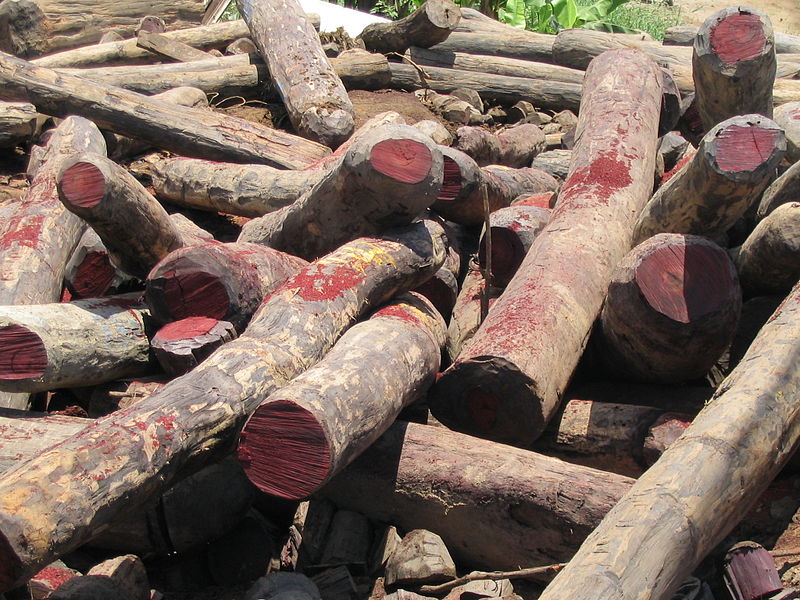- Rosewood refers to a large group of deeply-hued, durable timbers used for making expensive furniture as well as musical instruments like guitar. Majority of rosewoods belong to Dalbergia genus.
- At a recent conservation meeting, governments voted to include all rosewood species belonging to Dalbergia genus under CITES protection, launching a clampdown on the illegal trade of rosewood.
- This increased CITES protection means that all international trade in Dalbergia rosewoods will be subject to trade restrictions.
The multi-billion-dollar rosewood trade has wreaked havoc on some of the world’s most endangered old-growth forests. But now, protection for rosewood — the most trafficked wild product in the world — has received a boost.
At a recent conservation meeting, governments voted to include all rosewood species belonging to Dalbergia genus under CITES protection, launching a clampdown on the illegal trade of rosewood used for making luxury furniture in China. This increased CITES protection means that all international trade in Dalbergia rosewoods will be subject to trade restrictions. The decision was taken at the 17th meeting of the Conference of the Parties (CoP17) to CITES in Johannesburg, South Africa.
“These listings send a strong signal to governments in countries where Dalbergia species are still found, that trade may only be permitted when accompanied by documentation verifying that the specimen in question was harvested legally and without further detriment to the health of the species – some of which, such as Siamese rosewood (D. cochinchinensis), have been harvested nearly to the point of commercial extinction,” Naomi Basik Treanor, Manager of the Forest Policy, Trade, and Finance program at Forest Trends, told Mongabay.

Rosewood refers to a large group of deeply-hued, durable timbers of high economic value, largely used for making expensive furniture as well as musical instruments like guitar. The majority of rosewoods belong to Dalbergia genus. But the term rosewood has also been loosely ascribed to other genera such as Jacaranda, Guibourtia, Machaerium and Pterocarpus, many of which look similar to Dalbergia species. This poses a serious challenge for law enforcement, according to Treanor.
“The rosewood trade is characterized by ‘boom and bust’ cycles,” Treanor said. “Illicit trading networks move from species to species (or sub-species, i.e. from one type of rosewood to another) and country to country with alarming ease once stocks of a certain species are exhausted, or once a country puts more rigorous regulatory protections or enforcement measures in place.”
The major demand for luxury rosewood products comes from China, and to a lesser extent from Vietnam. Traditionally, rosewood imports into China were sourced from Southeast Asian countries like Cambodia, Laos, Myanmar and Vietnam. But China’s surging appetite for rosewood, locally referred to as “hongmu”, has resulted in over-logging — and often illegal logging — of Asia’s tropical forests.
To keep up with booming demands, traders have turned to forests of Central America and West Africa. From 2010 to 2014, China’s rosewood imports from Africa jumped 700 percent, according to Forest Trends. And in the first half of 2016 alone, China imported nearly $216 million worth of West African rosewood.
The illicit hongmu trade has not just wiped out forests, but has also been linked to violence and organized crime. In Thailand for example, hundreds of forest rangers, police personnel and illegal loggers have been killed during rosewood enforcement operations in recent years, a report by EIA found.
Similarly, in West Africa, hongmu species are sometimes called “blood” or “conflict” timbers because of the link between the illegal hongmu trade and intra-state conflict. In fact, the Senegalese government classifies 95 percent of the rosewood illegally traded across the border with Gambia as “conflict timber,” Treanor said, since it originates in the Casamance region which is held by rebel forces. “The export of logs is banned under Senegalese law,” she added.

In another positive move, the CITES meeting also extended protection to a West African rosewood species (Pterocarpus erinaceus), known as Kosso. This is a huge victory, Treanor said. “Kosso is now the world’s most heavily traded rosewood species, and African governments have historically lacked the capacity to properly enforce their own and regulations that protect it.”
Similarly, listing 13 rosewood species endemic to Mexico and Central America also sends a strong signal from these governments that Latin America will not be the world’s next illegal rosewood trade frontier, Treanor added.
However, it will take much more than CITES listing to stomp out the illegal rosewood trade, conservationists say.
“As a species-focused mechanism, CITES alone isn’t equipped to protect critically threatened forests from illegal logging as a whole,” Kerstin Canby, Director of the Forest Policy, Trade, and Finance program, said in a statement. “It’s up to consumer countries to adopt broader policy solutions that tackle the problem at its root – demand.”
“As the world’s largest consumer of rosewood, China holds the key to preventing the loss of the last remaining old-growth forests in Africa and Southeast Asia,” Canby added. “Requiring that all wood products be legally and sustainably sourced – rather than only certain listed species – is a proven approach that’s already getting illegal wood off of markets in the US, EU, and Australia. We urge the Chinese government to match the example set by those countries with strong policy measures of its own.”